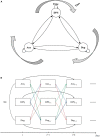Tracking perceived stress, anxiety, and depression in daily life: a double-downward spiral process
- PMID: 37143594
- PMCID: PMC10151810
- DOI: 10.3389/fpsyg.2023.1114332
Tracking perceived stress, anxiety, and depression in daily life: a double-downward spiral process
Abstract
Introduction: Previous studies using retrospective questionnaires have suggested a complex relationship between perceived stress and related negative emotions and emphasized their importance in mental health. However, how daily perceived stress, anxiety, and depression interact dynamically in a natural context remains largely unexplored.
Methods: This study conducted a longitudinal survey that applied experience sampling methodology to data from 141 Chinese college students (58% women, mean age = 20.1 ± 1.63 years).
Results: The hierarchical linear models confirmed that daily perceived stress and negative emotions (i.e., perceived depression and anxiety) could reciprocally reinforce one another with the characteristic dynamics of a cognitive-emotional downward spiral. Additionally, anxiety and depression could further circularly aggravate each other imminently. These two intertwined downward-spiral processes constitute a double-downward-spiral model.
Discussion: The findings contribute to a better understanding of the interactive mechanisms underlying perceived stress and its related negative emotions in everyday life and highlight the significance of early emotion regulation and stress relief in healthy people.
Keywords: anxiety; depression; downward spiral model; experience sampling methodology (ESM); perceived stress.
Copyright © 2023 Feng, Xu and Lei.
Conflict of interest statement
The authors declare that the research was conducted in the absence of any commercial or financial relationships that could be construed as a potential conflict of interest.
Figures

References
-
- Armon D. B., Fine N. B., Seligman Z., Ginzburg K., Ben-Zion Z. (2021). COVID-19 epidemic-induced changes in mood and anxiety mediate the relationship between resilience and symptoms of depression and generalized anxiety in sexual assault survivors. J. Affect. Disord. Rep. 6:100252. 10.1016/j.jadr.2021.100252 - DOI - PMC - PubMed
LinkOut - more resources
Full Text Sources

